Laser cutting cost has gained immense popularity across various industries due to its precision and efficiency. However, understanding the cost structure associated with laser cutting services can be complex. This response will delve into the factors that significantly influence the cost of laser cutting, providing insights into how these elements interplay to determine the final price for customers.
1. Material Type
The type of material being cut is one of the primary factors that influence the cost of laser cutting. Different materials have varying levels of thickness, density, and composition, which affect how they interact with the laser beam. Common materials include:
- Metals: Steel, aluminum, brass, and copper are popular choices. Metals typically require higher power settings and can incur higher costs due to the need for specialized equipment.
- Plastics: Acrylic and polycarbonate are widely used, and they can often be cut with lower power settings, leading to reduced operational costs.
- Wood: While wood can be cut relatively easily, different species can have varying densities and moisture content, affecting the laser's performance.
- Composites: Materials like carbon fiber or fiberglass can require specific techniques and careful handling, influencing the price.
Each material type has its own cutting speeds, gas requirements (like oxygen or nitrogen), and post-processing needs, all contributing to the overall cost.
2. Material Thickness
The thickness of the material being cut also plays a critical role in determining costs. Thicker materials generally require more powerful lasers, longer cutting times, and more energy consumption. For example:
- Thin Materials: Cutting through thin sheets (1mm or less) is faster and typically less expensive.
- Medium Thickness: Materials between 1mm to 10mm can vary in cost depending on the complexity of the cut.
- Thick Materials: Cutting materials over 10mm may require specialized equipment and techniques, resulting in a higher cost due to increased labor and machine wear.
Manufacturers often charge a premium for thicker materials because of the additional resources needed for effective cutting.
3. Complexity of Design
The complexity of the design or pattern being cut is another significant factor in pricing. Simple cuts may be straightforward and quick, whereas intricate designs require more time, precision, and setup. Key considerations include:
- Geometric Complexity: Designs with sharp corners or intricate details may slow down the cutting process.
- Nesting Efficiency: How well the designs fit together on the material sheet affects waste and, subsequently, costs. Efficient nesting can minimize material waste and reduce the cost per part.
- Multiple Cuts: If a design requires multiple passes or layers, this can significantly increase the labor time and machine usage, leading to higher costs.
4. Production Volume
The quantity of parts being produced can influence the overall cost of laser cutting. Generally, larger production volumes can lower the per-unit cost due to economies of scale. Factors to consider include:
- Setup Costs: These are often a fixed cost associated with preparing the laser cutting machine for a job. When producing a larger volume of parts, this setup cost is spread over more units, reducing the cost per item.
- Batch Processing: Running multiple parts in a single batch can optimize machine usage and reduce overall cutting time.
Conversely, low-volume or one-off jobs may incur higher costs due to the same setup costs being applied to fewer items.
5. Machine Type and Technology
The type of laser cutting machine used can greatly impact the cost. There are several technologies in the market, such as:
- CO2 Lasers: Commonly used for non-metal materials, CO2 lasers offer good cutting quality but may have slower speeds on thicker materials.
- Fiber Lasers: More efficient for cutting metals, fiber lasers can provide faster cutting speeds and lower operational costs for metal parts, but they may come with a higher initial investment.
The choice of machine affects the operational costs, maintenance requirements, and energy consumption, all of which influence the pricing of laser cutting services.
6. Labor Costs
Labor costs can vary significantly based on several factors:
- Skill Level: The expertise required to operate the laser cutting machinery can influence costs. Highly skilled operators may command higher wages, impacting the overall cost of the service.
- Setup and Supervision: More complex projects may require additional labor for setup, monitoring, and post-processing, which can increase costs.
- Geographical Location: Labor rates vary by region, with urban areas typically having higher wage rates than rural locations. This regional variance can affect the overall pricing for laser cutting services.
7. Lead Time
The urgency of a project can also impact the cost. Rush orders typically incur additional fees as they may require prioritization over other jobs. Factors to consider include:
- Scheduled Capacity: If a shop is already at capacity, accommodating rush jobs may require overtime or reallocation of resources, leading to higher costs.
- Planning and Preparation: Jobs that require quick turnarounds may not benefit from efficient planning, potentially resulting in increased costs.
Understanding the lead time expectations can help customers assess how it impacts the overall pricing.
8. Post-Processing Requirements
After the cutting process, parts may require additional finishing processes such as:
- Deburring: Removing sharp edges or burrs from the cut edges can add to the labor time and, consequently, the overall cost.
- Surface Treatment: Processes like anodizing, painting, or coating can increase costs due to additional materials and labor.
- Assembly: If parts need to be assembled after cutting, this adds complexity and labor costs, affecting the total price.
Customers should consider these potential post-processing steps when budgeting for laser cutting projects.
9. Quality Standards and Certifications
Certain industries may require compliance with specific quality standards or certifications, which can influence costs. For instance:
- ISO Standards: Complying with ISO standards may necessitate additional inspections, documentation, and process controls that can increase overall costs.
- Industry-Specific Regulations: Sectors such as aerospace or medical may have stringent quality requirements that add to the pricing due to the need for specialized processes or equipment.
Understanding the necessary quality standards is essential for accurately assessing costs.
10. Energy Costs
Laser cutting machines consume significant amounts of energy, and fluctuations in energy prices can impact overall costs. Key considerations include:
- Power Consumption: The laser's power rating influences operational costs, with higher wattage machines typically consuming more energy.
- Operational Hours: The total number of hours a machine operates also affects energy costs. Running machines during peak hours may incur higher electricity charges.
Overall, customers should account for energy costs when budgeting for laser cutting projects.
Conclusion
In summary, the cost of laser cutting services is influenced by a multitude of factors, including material type, thickness, design complexity, production volume, machine technology, labor costs, lead times, post-processing needs, quality standards, and energy consumption. By understanding these elements, customers can make informed decisions regarding their laser cutting projects and better anticipate the associated costs.
While the intricacies of laser cutting pricing can be complex, recognizing the interplay of these factors can aid in optimizing processes and ultimately achieving more cost-effective solutions.








